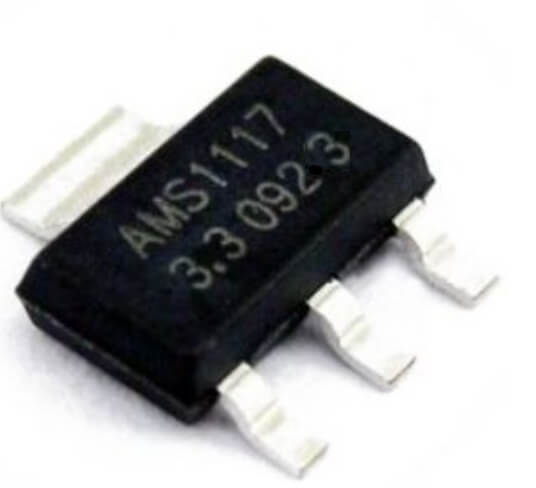In this post I will be talking about one famous voltage regulator IC called AMS1117. It is a 1 Amp Low Dropout (LDO) Linear Voltage Regulator and we can get it in both fixed output types and also adjustable output version. It is super small, easy to use and available in SOT-223 package mostly, which means flat-type with three legs.
If you are making Arduino stuff or ESP projects or any 3.3V or 5V gadgets then this AMS1117 is like our bread and butter, right!

What this AMS1117 does actually?
So this chip, what it does is, it takes higher voltage at input (like 5V, 12V, etc) and gives a lower stable voltage at output like 3.3V, 5V, 1.8V, etc. That too with low dropout means it can work even if input is just a bit higher than output.
For example if we use AMS1117-3.3 it will give 3.3V output even if input is just like 4.5V or 5V. That is what we call LDO – Low Dropout, unlike old 7805 which needs 7V+ input for 5V output.
Types of AMS1117 You Can Get
We get different versions of this chip:
| Variant | Output Voltage | Adjustable? |
|---|---|---|
| AMS1117-5.0 | 5.0V Fixed | No |
| AMS1117-3.3 | 3.3V Fixed | No |
| AMS1117-2.5 | 2.5V Fixed | No |
| AMS1117-1.8 | 1.8V Fixed | No |
| AMS1117 (Adj) | Adjustable | Yes (1.25V to 12V max) |
So if you want simple plug-n-play voltage then just take fixed version. But if you want to set voltage as per your circuit, then go for the adjustable version.
Pinout Details of AMS1117 (Same for all versions)

Usually 3 pins + tab (heat sink pad):
- Pin 1 (ADJ or GND) → For fixed version, this is GND.
For adjustable version, this is Adjust pin. - Pin 2 (Vout) → Output voltage.
- Pin 3 (Vin) → Input voltage (should be 1.1V more than output min).
- Tab → Internally connected to Vout, used for heat sinking.
Internal Working – Simple Talk
Inside this AMS1117 there is a voltage reference (1.25V), some error amplifiers, and a series pass transistor. When input comes, then it compares the voltage and adjusts the pass transistor to give steady output.
In adjustable one, it keeps 1.25V between Vout and Adjust pin, so we can change output using external resistors.
How to Set Output in Adjustable Version
We use this formula:
Vout = 1.25 × (1 + R2 / R1)
We can also add a capacitor for better stability.

Example: If we want 5V output, we can select:
R1 = 220 ohms
R2 = 660 ohms
Then Vout = 1.25 × (1 + 660 / 220) = 5V approx
We can use 10K trimmer as R2 to adjust it easily.
Current and Voltage Ratings
- Max Output Current: 1 Amp (with heatsink).
- Max Input Voltage: 15V (but better to keep it under 12V for safety).
- Dropout Voltage: Around 1.1V when load is 800mA to 1A.
- Power Dissipation: Depends on heatsink and PCB pad.
- Thermal Shutdown and Short Circuit Protection: Yes built-in.
How to Keep it Cool
This thing gets hot if you draw full 1A and drop high voltage (difference between input and output voltage).
Say, you input 12V and take 3.3V at 1A →
Then that means 12V - 3.3V = 8.7V × 1A = 8.7 Watts heat, that is equivalent to = fire hazard.
So use it only for small loads (under 500mA) or use big copper pad, heatsink or go for switching regulator like buck converter.
Where We Use AMS1117?
- ESP8266 / ESP32 3.3V power supply.
- Arduino sensors that need 3.3V.
- Low-noise analog circuits.
- Battery-powered circuits needing stable voltage.
- Raspberry Pi peripherals.
- Custom PCBs and breadboard projects.
Example Application Circuit (Fixed Voltage Output)

bonsoir monsieur comment allez-vous. s’il vous plait je peux avoir un schéma électronique d’un contrôleur des phases trophées. merci